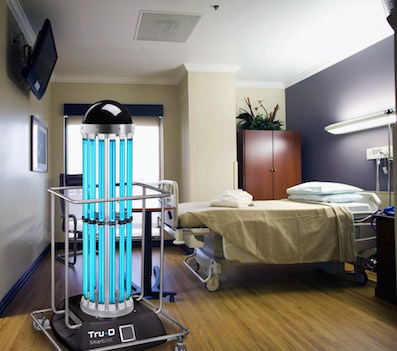 Cleanzine: your weekly cleaning and hygiene industry newsletter 10th July 2025 Issue no. 1170
Cleanzine: your weekly cleaning and hygiene industry newsletter 10th July 2025 Issue no. 1170
Your industry news - first
The original and best - for over 20 years!
We strongly recommend viewing Cleanzine full size in your web browser. Click our masthead above to visit our website version.
Hospital sees 12% C. diff reduction in two-year, CDC-funded study
 With the help of a fleet of germ-eliminating UV robots, Chesapeake Regional Healthcare (CRH) experienced a marked decrease in its Clostridium difficile infection rates.
With the help of a fleet of germ-eliminating UV robots, Chesapeake Regional Healthcare (CRH) experienced a marked decrease in its Clostridium difficile infection rates.
After participating in a study on UV disinfection and seeing significant results, CRH has invested in Tru-D SmartUVC to help with its infection rates.
The 310-bed facility was one of nine hospitals that participated in the recently-published 'Enhanced terminal room disinfection and acquisition and infection caused by multidrug-resistant organisms and Clostridium difficile (the Benefits of Enhanced Terminal Room Disinfection-BETR-D-study): a cluster-randomised, multicentre, crossover study which was published in The Lancet.
The two-year study conducted from 2012-2014 is said to be the first and only randomised clinical trial on UV disinfection. In the study, rooms with a known C. diff patient were treated with bleach daily as well as at discharge and had a high 90% compliance rate for both manual disinfection processes as well as handwashing. For those rooms in the UV arm of the study, each room was disinfected with a Tru-D SmartUVC robot following manual bleach disinfection.
"We did experience a significant decrease in both infection and colonisation rates with all multidrug-resistant organisms (MDROs) and about a 12% decrease in C. diff infections during the arms of the study that included Tru D units and bleach," reports Tiffany Silmon, director, infection prevention and control, at Chesapeake Regional Healthcare.
The study, which was funded by the Centers for Disease Control & Prevention, examined the impact of UV disinfection on the spread of four major superbugs-MRSA, VRE, Acinetobacter and C. diff. Results proved that enhanced terminal room disinfection strategies that utilised Tru-D SmartUVC reduced the risk of acquisition and infection for the next patient who entered the room by a statistically significant, cumulative 30%.
Chuck Dunn, CEO and president of Tru-D SmartUVC, says of the study: "The BETR-D study proved not only that UV disinfection is effective in reducing the spread of infections in healthcare facilities, but that the environment is a critical source of contamination.
"The primary outcome of the BETR-D study was a cumulative 30% reduction across all major MDROs for the next patient who entered the room, and an expanded secondary analysis of all patients in the hospital revealed an 11% C. diff reduction, which was statistically significant."
Used in conjunction with manual cleaning protocols, Tru-D is brought in to a hospital room after traditional cleaning is completed. It operates from a single position and administers a single cycle of UV light, minimising additional labour costs associated with UV offerings requiring multiple placements per room and maximising productivity for the staff. The only device of its kind with patented Sensor360 technology, Tru-D analyses the space including size, shape and contents, to deliver a precise, lethal dose of UV light, achieving significant pathogen reduction in the room.
13th April 2017







